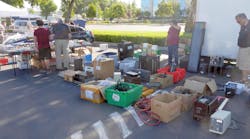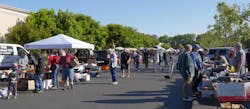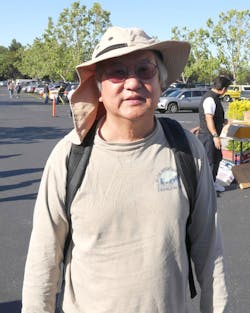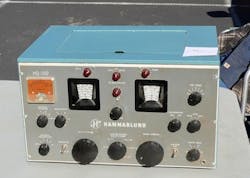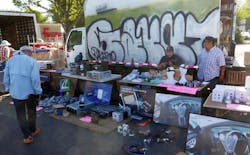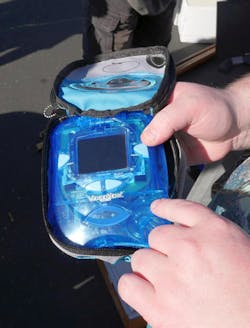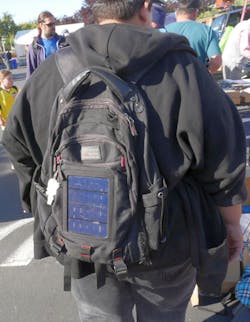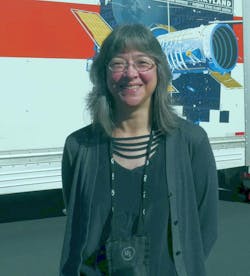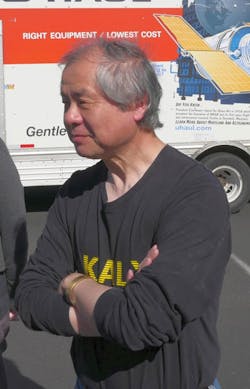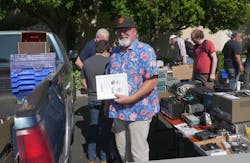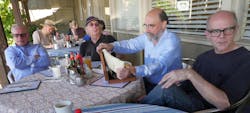Several ham radio clubs put on an electronics flea market in Silicon Valley during the summer months. They shut down from October to February, since Californians think 60°F is unbearably cold. My buddy Dave Ruigh calls it the eFlea, and that name has stuck with our pals. Last year, the eFlea was held on the second Saturday of the month at the Fry’s Electronics parking lot in Sunnyvale (Fig. 1).
1. The Silicon Valley Electronics Flea Market draws hundreds of people every month, from March to September, on the second Saturday.
The eFlea used to be held at the DeAnza community college parking lot. The college charged the ham club thousands of dollars and attendees had to pay three dollars for parking. The money paid to the college put pressure on the ham clubs to raise the cost of a booth, which was 20 dollars for an area of two parking spaces.
This bothered my pal Ed Fong, a fellow analog aficionado and former IC designer at National Semiconductor, now Texas Instruments (Fig. 2). Fong, who hosts ham radio events at his house, has designed an antenna that many ham enthusiasts swear by. So, Ed got to know the manager at the big Fry’s store in Sunnyvale where he lived. Every time he made a major purchase, he hunted down the manager, and told him how much he liked the store.
2. Ed Fong is an activist in the ham radio community. He was instrumental in getting Fry’s Electronics to host the eFlea at no cost to the ham clubs that put it on.
After about a year, Fong broached the idea of Fry’s letting the ham radio clubs hold the eFlea in the parking lot. Fong is a remarkable engineer, but I find his people skills even more remarkable for a tech person. Since Fry’s does not charge the club for the parking spaces, the clubs have a lot more money to use for programs and charity work. I feared Fry’s might regret the decision to let a hoard of tech types loose in the parking lot, but Fong assured me that Fry’s is delighted with the way things turned out, since they get a lot of walk-in business on the day of the flea market. A classic win-win scenario engineered by Fong, to his credit.
So, What Do They Have?
Since the eFlea was started by ham clubs, there’s always some ham gear for sale. You can find everything from radios to backup batteries. I really enjoy the vintage gear, like a Hammarlund H1-150 short-wave receiver, made around 1952 (Fig. 3). Despite its age, some ham radio folks still prefer the HQ-150 for short-wave listening. Indeed, there are sites that have a pdf of the manual, with complete schematics. You can find the radio on eBay for around $300.
3. This Hammarlund HQ-150 short-wave receiver was for sale at the eFlea. Next to it was a model HQ-140, in slightly worse shape. Vintage ham gear and test equipment is a big draw to the eFlea.
Many of my friends are hams, but they also come for used test equipment and other salvage electronics (Fig. 4). There are many salvage operators that buy up failing companies or excess inventory and then bring it to the eFlea to sell. I got a kick from these old Catalyst Semiconductor posters. Catalyst was acquired by ON Semiconductor in 2008, which itself was a spinout of Motorola’s discrete and analog semiconductor operations back in 1999.
4. Many vendors are regular attendees. This is a salvage operator selling everything from lithium-ion batteries, to oscilloscopes, to power supplies.
In 2004, Motorola spun out its digital semiconductor business to Freescale. Freescale merged with NXP back in 2015. I used to bemoan this phenomenon—the big fish eating the little fish. Thing is, NXP stock has tripled in the last five years, so they must have known what they were doing. I was dismayed when Microchip bought Atmel in 2016, since I used to work for Atmel. Microchip stock has doubled in three years. That Sanghi guy is one sharp cookie.
There’s also plenty of interesting old consumer electronics at the eFlea, like a VideoNow video disk player (Fig. 5). It was brought out by Hasbro in 2003 to play 23-minute episodes of Nickelodeon and other shows. It shows how fast electronics has advanced. Today something this size can hold and display dozens of HD movies without resorting to spinning optical media. Something about these obsolete marvels appeals to engineers; I have several friends who collect LaserDisks.
5. This VideoNow player was for sale. It used CD protocols to record video on the left track and audio on the right. It’s a smaller size than a CD, but you can hack the case to take CD-Rs.
I got a blast from the past when I saw a solar charging backpack that was given to journalists by International Rectifier (now part of Infineon Technologies) a decade ago (Fig. 6). I think I gave mine away at the eFlea, since selling it for money seemed unethical. It’s likely this is the very same backpack that I had. It had a Li-ion battery inside that would charge from the solar panel. Then you could use that battery to power or charge other devices via a USB port.
6. This backpack has a solar cell that charges a lithium-ion battery. You can use it to keep your USB appliances running.
A Friendly Place
One great reason to go to the eFlea is to catch up with friends. I met up with Keiko Kaleta, who I worked with at National Semiconductor, now Texas Instruments, back in 2002 (Fig. 7). She has since moved to iWatt, the wall-wart power startup, which was then acquired by British semiconductor analog powerhouse Dialog Semiconductor. Kaleta is a program manager with a process engineer background. She cut her teeth in the Fairchild fabrication facility in Portland, Maine, before moving to Silicon Valley. That’s the great thing about electronics, talented people can work anywhere in the world they desire.
7. Keiko Kaleta frequents the eFlea when she’s not in her office at Dialog Semi. The bright sun has reddened her cheeks.
Ron Quan was also at the May 2018 eFlea (Fig. 8). Ron is an accomplished systems engineer who holds hundreds of worldwide patents. When I worked at EDN magazine, I connected him with a book publisher who wanted a tech book for makers. Ron wrote his great book, Build Your Own Transistor Radios: A Hobbyist's Guide to High-Performance and Low-Powered Radio Circuits. In the realm of tech books, it was a runaway best-seller. Quan followed up with another book, Electronics from the Ground Up: Learn by Hacking, Designing, and Inventing. Ron has the rare ability to both invent and communicate. If you go to the eFlea, you will likely see him there.
8. Ron Quan is a great engineer and ham radio aficionado. He has written several books and articles that are wildly popular.
My friend Martin DeLateur has a large double-space booth at the eFlea (Fig. 9). I have dubbed DeLateur “the international man of mystery,” since he ran a Fairchild plant in the Philippines before I met him as a product engineer at National Semiconductor. His travels make him international, but the mystery is how he got so smart on so many things. This includes everything from device physics to RC models to boat and chainsaw engines. He has retired from the semiconductor industry and now buys and sells stuff at the eFlea, various auctions, and Craigslist. His booth is meticulously organized, and it’s always a popular attraction at the eFlea.
9. Martin DeLateur, the international man of mystery, shows off a pamphlet on how to make 3-phase power. His booth at the eFlea is a popular one.
Several friends go to Bobbie's Cafe for breakfast after the eFlea (Fig. 10). All are welcome, sometimes a dozen people show up. We use the breakfast as a show-and-tell for all the things we just bought. It also lets us solve the problems of the world. We get there about 9:30 and often stay well past noon. There are a lot of problems to solve.
10. After walking the eFlea, many folks go to Bobbie’s Cafe for breakfast. Leftmost is Phil Sittner, a retired electrical distributor; audio guru Steve Williams is also retired. Vini Carter, recording engineer, amateur astronomer, concert musician, and teacher, is sharing an ancient Brüel & Kjær test microphone with the group. On the far right is mechanical engineer Dave Ruigh, who invented the term “eFlea” for the electronics flea market.
That’s the great thing about the eFlea. It’s a “stuff” place, which any engineer can enjoy, but there’s also that social aspect where you can meet like-minded people and learn more about the stuff and about each other. It’s such an enjoyable experience—I fly back from Florida at least once a year to check it out. Think about putting the Silicon Valley eFlea on your to-do list. If there are any similar events in your city, be sure to let us know in the comments.
